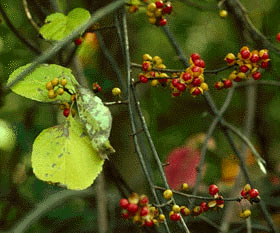
The Celastraceae are a family of 98 genera and 1,350 species of herbs, vines, shrubs and small trees, belonging to the order Celastrales. The great majority of the genera are tropical, with only Celastrus, Euonymus and Maytenus widespread in temperate climates, and Parnassia (bog-stars) found in alpine and arctic climates.

Celastrus, commonly known as staff vine, staff tree or bittersweet, is the type genus of the family Celastraceae; it contains over 40 species of shrubs and vines, which have a wide distribution in East Asia, Australasia, Africa, and the Americas.

Argyreia is a genus of plants in the family Convolvulaceae.
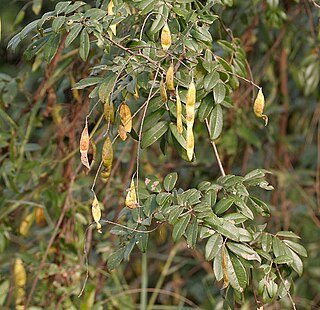
Derris is genus of leguminous plants. It contains 65 species, which range from eastern Africa to the Indian subcontinent, Southeast Asia, New Guinea, northern Australia, and the southwest Pacific islands. The roots of D. elliptica contain rotenone, a strong insecticide and fish poison.
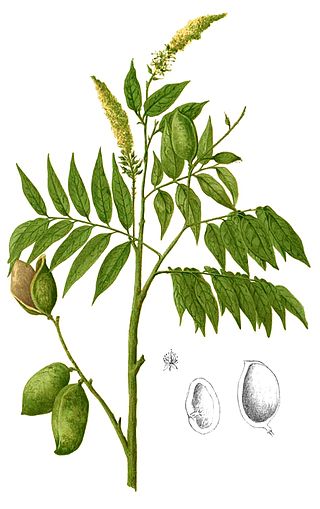
Crudia is a genus of plants in the family Fabaceae.

Ormosia is a genus of legumes. 131 living species, mostly trees or large shrubs, are native to the tropical Americas, from southwestern Mexico to Bolivia and southern Brazil, to southern, southeastern, and eastern Asia, and to New Guinea and Queensland. Most are tropical, while some extend into temperate temperate regions of China. A few species are threatened by habitat destruction, while the Hainan ormosia is probably extinct already.

Bhesa is a small genus of woody plants in the family Centroplacaceae. Its natural distribution is from southern China to New Guinea. It was formerly classified in Celastraceae, until a molecular phylogenetic study placed it in the family Centroplacaceae in the order Malpighiales.
Glyptopetalum pallidifolium is an ornamental shrub in the family Celastraceae. It is endemic to Taiwan. It is threatened by habitat loss and considered critically endangered. Glyptopetalum pallidifolium grows in evergreen forests on raised coral reefs. The plant's entire remaining habitat is located in the Kenting National Park in Taiwan.

Gymnosporia is an Old World genus of plants, that comprise suffrutices, shrubs and trees. It was formerly considered congeneric with Maytenus, but more recent investigations separated it based on the presence of achyblasts and spines, alternate leaves or fascicles of leaves, an inflorescence that forms a dichasium, mostly unisexual flowers, and fruit forming a dehiscent capsule, with an aril on the seed. It is dioecious, with male and female flowers on separate plants.
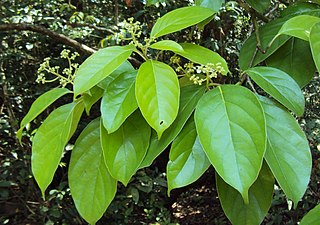
Mastixia is a genus of about 19 species of resinous evergreen trees, usually placed in the family Cornaceae. Its range extends from India through Southeast Asia and New Guinea to the Solomon Islands. Mastixia species have alternate or opposite simple broad leaves, many-flowered inflorescences, and blue to purple drupaceous fruits.

Microtropis is a genus of plant in the family Celastraceae. There are about 70 species. They are trees and shrubs, evergreen or deciduous, with oppositely arranged leaves and white or yellowish flowers. Microtropis are distributed in Asia, Africa, and Central America.

Polyalthia is a genus of flowering plants in the family Annonaceae. There are approximately 90 species distributed from Africa to Asia and the Pacific.
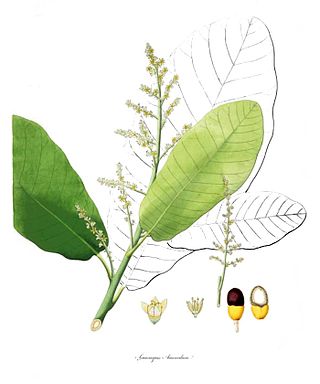
Semecarpus is a genus of plants in the family Anacardiaceae. It includes 87 species native to the Indian subcontinent, Indochina, Malesia, Taiwan, Papuasia, Queensland, and the South Pacific.
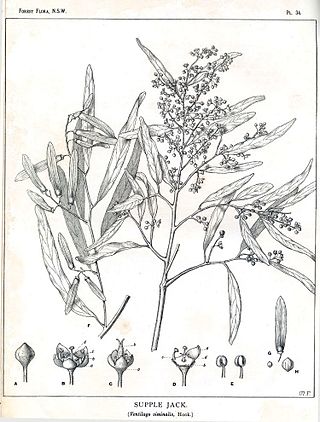
Ventilago is a genus of plants in the family Rhamnaceae. It includes about 40 species found in the tropics of South and SE Asia, Australasia, with one species each in Africa and Madagascar.
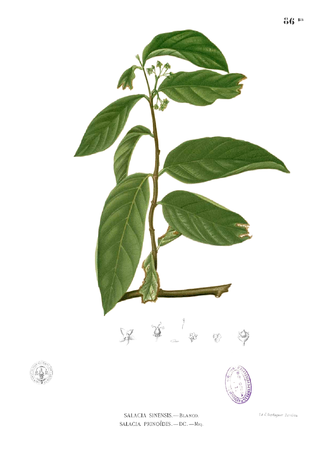
Salacia is a genus of plants in the family Celastraceae. They are woody climbers naturally found in tropical regions.
Hedyotis (starviolet) is a genus of flowering plants in the family Rubiaceae. Many species of this genus such as Hedyotis biflora, H. corymbosa and H. diffusa are well known medicinal plants. Hedyotis is native to tropical and subtropical Asia and to islands of the northwest Pacific. It comprises about 115 species. The type species for the genus is Hedyotis fruticosa.

Erycibe is a genus of plants in the family Convolvulaceae, found in the Andaman Islands, Sri Lanka, India including Assam, Bangladesh, Myanmar, east Himalaya, southern and southeastern China including Hainan and Taiwan, Southeast Asia, Malesia, Papuasia, Australia, and Japan including the Ryukyu Islands.















